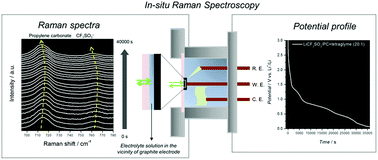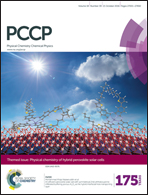In situ Raman investigation of electrolyte solutions in the vicinity of graphite negative electrodes
Abstract
The structure of electrolyte solutions plays an important role in the lithium-ion intercalation reaction at graphite negative electrodes. The solvation structure of an electrolyte solution in bulk has been investigated previously. However, the structure of an electrolyte solution at the graphite negative electrode/electrolyte solution interface, where the lithium-ion intercalation reaction occurs is more important. In this study, the structure of electrolyte solutions in the vicinity of a graphite negative electrode was investigated using in situ Raman spectroscopy during the 1st reduction process in 1 mol dm−3 LiClO4/ethylene carbonate (EC) + diethyl carbonate (DEC) (1 : 1 volume ratio), 1 mol dm−3 LiCF3SO3/propylene carbonate (PC), and 1 mol dm−3 LiCF3SO3/PC + tetraethylene glycol dimethyl ether (tetraglyme) (20 : 1 volume ratio). As a result, in the electrolyte solutions in which the lithium-ion intercalation reaction can occur (LiClO4/EC + DEC and LiCF3SO3/PC + tetraglyme), the Raman spectra of free solvent molecules (EC or PC) and anions showed a positive vibrational frequency shift during the co-intercalation reaction, and these shifts returned to their original positions during the lithium-ion intercalation reaction. On the other hand, there is no vibrational frequency shift in LiCF3SO3/PC, an electrolyte in which the lithium-ion intercalation reaction cannot occur. Based on our results, the relationship between the Raman shift and the solid electrolyte interphase (SEI) formation process was discussed.


 Please wait while we load your content...
Please wait while we load your content...